Values, Effort and QA
This paper is based on the argument in Chapter 5 "Of Sisyphus and Snowballs" of Atherton J S (1989) Interpreting Residential Life; values to practise London; Tavistock which was based on issues in residential social care. This version has prettier pictures and is about the practice of teaching and developing and "delivering" courses. It fits fairly well with Hadfield P and Atherton J (2008) "Beyond Compliance" paper presented at 16th Improving Student Learning conference, Durham UK, 1-3 September 2008 now published as "Beyond Compliance; accountability, assessment and anxiety, and curricular structures to help students engage with troublesome knowledge" in C Rust (ed.) (2009) Improving Student Learning: through the Curriculum Oxford; Oxford Centre for Staff and Learning Development pp.158-170. See that paper for a more comprehensive list of references.
Left to themselves, taught programmes and the practice of teaching will settle at the level of administrative convenience, or more informally, least hassle. This is not a criticism. It is a property of many systems, and I first explored it twenty years ago in residential and day-care programmes. But certain features do follow from it which provide some useful perspectives on quality assurance (QA) and enhancement (QE), and leadership, and important considerations in selecting staff, and...
A curve, mapping quality and effort
If one sets up a notional graph (notional because articulating the variables so as to measure them is a more complex task than it is worth undertaking--unless you fancy doing a PhD...), with the y axis representing the amount of effort required to make a system work, and the x axis representing the quality of the service or, closer-up, the practice delivered, then it will follow a j-curve. In other words, it looks like a letter j. Just as with an s-curve, the term is only a convenient way of describing a shape, and if you look at such curves in any discipline seeking common factors beyond the shape, you will get nowhere.
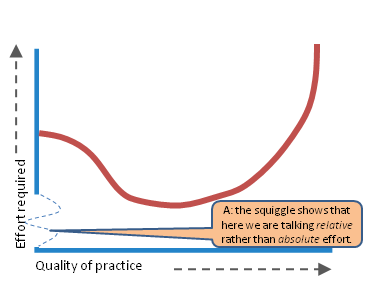
The J-curve suggests that, in accordance with basic physical principles, the system will tend towards the state of maximum entropy (disorder), i.e. the state in which least energy is required to maintain it. Imagine the curve as a physical surface; start a ball rolling from any point and it will descend and ultimately settle at the bottom.
But the bottom of the curve is not the bottom of the graph. 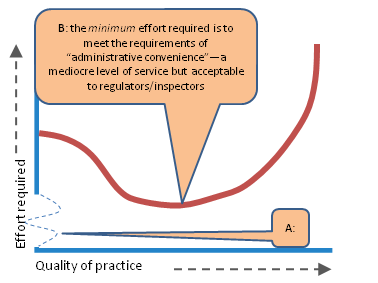
B: In practice, the system descends to a minimum acceptable level; and what constitutes an acceptable level is determined by regulators and accreditors and inspectors, with whose demands the system has to comply. Fail to comply and the course will be closed, the teacher will be disciplined, funding will be withdrawn. There is a range of sanctions which can be deployed (everywhere except in banking, it appears...).
So the minimum requirement to get by is compliance; and theoretically at least, that is determined by what is needed to produce an acceptable quality of provision/ service/ practice.
Of course, whether or not you agree with the authority's definitions of quality of practice is a different matter. For example, one course I work on does not grade student work, as a matter of policy. Our inspectors are keen on grading, so they mark us down because we don't do it... Actually, they now appear to have conceded defeat after many years.This level of compliance we call "administrative convenience". It is determined not by the quality of practice, but by the external regulations (which may be good proxies for quality of practice, but ain't necessarily so).
C: So if for whatever reason you want offer a course which is worse than the level of administrative convenience, you are actually going to have to work harder to do so.
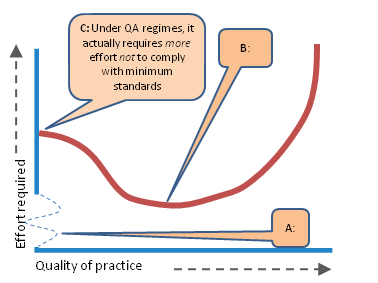
D: But the curve continues to the right, in the direction of better practice, and it is possible that even more effort is put in, beyond the requirements of the regulators and inspectors (and indeed beyond the point at which support is forthcoming from college management, for whom that external endorsement and funding is what matters--everything else is "wasted effort").
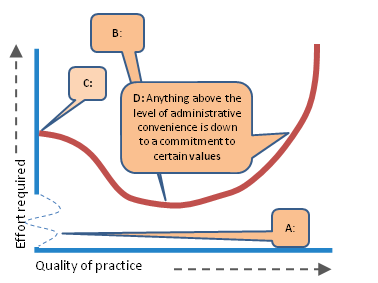 Where does the energy come from to work at that level, often without support? It comes from, indeed it is the "outward and visible sign" of, the values of the programme. Values which are embodied in the community of practice which is the course, which belong to all the (much-discredited word, now) "stakeholders"�the managers, the leaders, the tutors, the students, the
mentors....
Where does the energy come from to work at that level, often without support? It comes from, indeed it is the "outward and visible sign" of, the values of the programme. Values which are embodied in the community of practice which is the course, which belong to all the (much-discredited word, now) "stakeholders"�the managers, the leaders, the tutors, the students, the
mentors....
Commitment to these values (I am making no judgement about the values themselves�they vary from those of Summerhill to the boot camp, from Newman to Gradgrind...) is shown precisely in the effort that people are prepared to expend to put them into practice. And essentially they come from the bottom up, not from the vacuous if high-flown "mission statements" of institutions.
E: But any set of values contains contradictions. The almost vertical right-hand side of the J-curve depicts a situation where ever more effort is being put into developing practice, and it is making no difference. The law of diminishing returns sets in. The curve may even turn back on itself, so the harder you try the worse the provision gets.
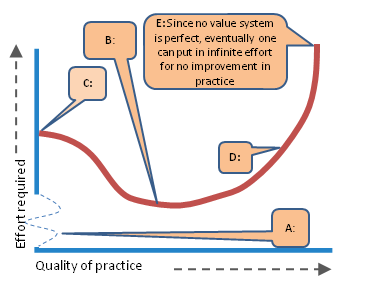
|
One course on which I worked was heavily committed to the principles of andragogy, and the self-determination of adult learners. So there were no arbitrary deadlines for assessments. Tutorial support was offered, but it was left to students to decide whether and when they wanted it, and they only got it if they asked for it. Unfortunately (but not surprisingly given their previous experience of educational institutions) they concluded that such benign neglect meant that we didn't care whether they passed or not, and that the course wasn't important. |
Dynamic aspects
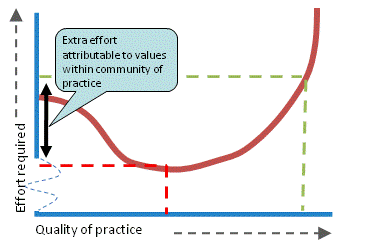
It is chiefly down to them because they can�with sufficient commitment and enthusiasm, but sometimes at considerable personal cost�overcome to some extent the disinterest or even obstruction of those more exalted in the hierarchy. But for reasons we shall come to, the managers can not�for all their delusions of power�impose genuine enthusiasm and commitment on their staff. Indeed, attempts to do so through motivational surrogates such as incentive schemes are often counter-productive (I could produce some references for this, but I can't be bothered. Anyone who is interested is likely to be earning more than me already, so they can look it up for themselves. :-) )
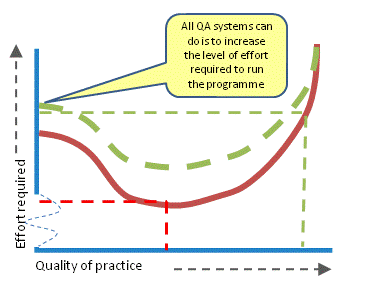
All that QA systems do is to raise the bar for the level of administrative convenience. They do not automatically shift the curve to the right (i.e. improve the quality of the practice/service.) Indeed, they may well diminish that quality by diverting time, effort, and resources into producing the documentation which sustains them (cf. Coffield, 2008)
Actually, that is not entirely fair. Wenger (1998) suggests that communities of practice are constituted (looked at in one way) out of two complementary ingredients. On is the reified part, which is the practice made (sometimes literally) concrete, in the buildings, the equipment, the forms and procedure manuals which are necessary to enable it to happen. These are relatively permanent and for better or for worse resistant to change. And, of course, this is the part which is most affected by QA systems and inspection and regulatory regimes. Insofar as these concrete features do embody values�and of course they do�they are reinforced by the formal procedures.
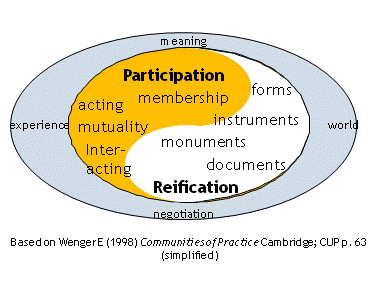
But these reified components tend to be the shared base of practice, rather than distinctive and innovative and even creative elements.
Those tend to be the province of the participatory processes, which stem from the interactions within the team or community (again for better or for worse), from the way in which new colleagues are socialised and inducted, and from the "custom and practice" of the workplace. Although on the whole the participatory processes are "softer", more fluid and more ephemeral than the reified ones, they are more responsive, more adaptable and more creative. And this is where that distinctive added value comes from.
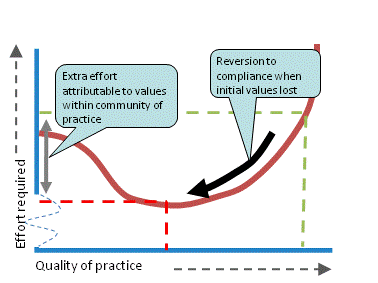
But it takes very little to lose it. The departure of a key member of the team. The disillusionment when distinctiveness is not recognised. The failure to transmit a "vision" to new members of a churning team...
The standard reverts all too readily to the level of administrative convenience. "Eternal vigilance is the price of liberty" (Curran, 1790)
Exceptional qualities (both good and bad, but more particularly good) cannot be built into a programme in a stable form, regardless of the assumptions of TQM and Deming...
So that is why despite some reservations, it may be worth watching this;
References
Coffield F (2008) Just suppose teaching and learning became the first priority� London; Learning and Skills Network
Wenger E (1998) Communities of Practice Cambridge; Cambridge University Press
[20 May 2010]
Atherton J S (2013) Doceo; [On-line: UK] retrieved from
Original
material by James Atherton: last up-dated overall 10 February 2013 
This work is licensed under a Creative Commons Attribution-Noncommercial-No Derivative Works 3.0 Unported License.
Search Doceo and associated sites:
![]() Save this on Delicious Tweet
Save this on Delicious Tweet
 Click
here to send to a friend
Click
here to send to a friend
This site is independent and self-funded. The site does not accept advertising or sponsorship (apart from what I am lumbered with on the reports from the site Search facility above), and invitations/proposals/demands will be ignored, as will SEO spam. I am not responsible for the content of any external links; any endorsement is on the basis only of my quixotic judgement. Suggestions for new pages and corrections of errors or reasonable disagreements are of course always welcome.
